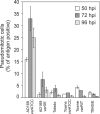Viral and cell cycle-regulated kinases in cytomegalovirus-induced pseudomitosis and replication
- PMID: 17206862
- PMCID: PMC1764433
- DOI: 10.1371/journal.ppat.0030006
Viral and cell cycle-regulated kinases in cytomegalovirus-induced pseudomitosis and replication
Abstract
A process of pseudomitosis occurs during human cytomegalovirus infection that appears similar to cellular mitosis but involves the formation of multiple spindle poles, abnormal condensation, and mislocalization of chromosomal DNA. The relationship of this process to viral replication and cell cycle regulation during infection has been poorly understood. Pseudomitosis consistently peaks at late times of infection in all viral strains examined but at overall highest frequencies (30% to 35% of cells) using one common laboratory strain variant (AD169varATCC). Cyclin-dependent kinase 1 (Cdk1) plays a crucial role in pseudomitosis, mirroring its role in conventional mitosis. Dominant negative Cdk1 inhibits and wild-type Cdk1 stimulates this process; however, viral yields remain the same regardless of pseudomitosis levels. Broad inhibition of cell cycle-regulated kinases (Cdk1/Cdk2/Cdk5/Cdk9) with indirubin-3'-monoxime substantially decreases viral yields and synergizes with the viral UL97 kinase inhibitor, maribavir. Thus, Cdk1 is necessary and sufficient to drive pseudomitosis, whereas a combination of viral and cell cycle-regulated kinases is important during viral replication.
Conflict of interest statement
Figures




Similar articles
-
Global analysis of host cell gene expression late during cytomegalovirus infection reveals extensive dysregulation of cell cycle gene expression and induction of Pseudomitosis independent of US28 function.J Virol. 2004 Nov;78(21):11988-2011. doi: 10.1128/JVI.78.21.11988-12011.2004. J Virol. 2004. PMID: 15479839 Free PMC article.
-
Viral mimicry of Cdc2/cyclin-dependent kinase 1 mediates disruption of nuclear lamina during human cytomegalovirus nuclear egress.PLoS Pathog. 2009 Jan;5(1):e1000275. doi: 10.1371/journal.ppat.1000275. Epub 2009 Jan 23. PLoS Pathog. 2009. PMID: 19165338 Free PMC article.
-
Autographa californica nucleopolyhedrovirus infection results in Sf9 cell cycle arrest at G2/M phase.Virology. 1998 Apr 25;244(1):195-211. doi: 10.1006/viro.1998.9097. Virology. 1998. PMID: 9581791
-
Viral infections and cell cycle G2/M regulation.Cell Res. 2005 Mar;15(3):143-9. doi: 10.1038/sj.cr.7290279. Cell Res. 2005. PMID: 15780175 Review.
-
When CDK1 rides the telomere cycle.Mol Cell. 2006 Nov 17;24(4):491-2. doi: 10.1016/j.molcel.2006.10.033. Mol Cell. 2006. PMID: 17188029 Review.
Cited by
-
Human cytomegalovirus glycoprotein B variants affect viral entry, cell fusion, and genome stability.Proc Natl Acad Sci U S A. 2019 Sep 3;116(36):18021-18030. doi: 10.1073/pnas.1907447116. Epub 2019 Aug 19. Proc Natl Acad Sci U S A. 2019. PMID: 31427511 Free PMC article.
-
The cyclin-dependent kinase ortholog pUL97 of human cytomegalovirus interacts with cyclins.Viruses. 2013 Dec 18;5(12):3213-30. doi: 10.3390/v5123213. Viruses. 2013. PMID: 24351800 Free PMC article.
-
Intercellular communication within the virus microenvironment affects the susceptibility of cells to secondary viral infections.Sci Adv. 2023 May 10;9(19):eadg3433. doi: 10.1126/sciadv.adg3433. Epub 2023 May 10. Sci Adv. 2023. PMID: 37163594 Free PMC article.
-
Benzimidazole analogs inhibit human herpesvirus 6.Antimicrob Agents Chemother. 2011 May;55(5):2442-5. doi: 10.1128/AAC.01523-10. Epub 2011 Feb 7. Antimicrob Agents Chemother. 2011. PMID: 21300829 Free PMC article.
-
Proteomic Interaction Patterns between Human Cyclins, the Cyclin-Dependent Kinase Ortholog pUL97 and Additional Cytomegalovirus Proteins.Viruses. 2016 Aug 18;8(8):219. doi: 10.3390/v8080219. Viruses. 2016. PMID: 27548200 Free PMC article.
References
-
- Bertout J, Thomas-Tikhonenko A. Infection & neoplastic growth 101: The required reading for microbial pathogens aspiring to cause cancer. Cancer Treat Res. 2006;130:167–197. - PubMed
-
- Tanner JE, Alfieri C. The Epstein-Barr virus and post-transplant lymphoproliferative disease: Interplay of immunosuppression, EBV, and the immune system in disease pathogenesis. Transpl Infect Dis. 2001;3:60–69. - PubMed
-
- Schulz TF. The pleiotropic effects of Kaposi's sarcoma herpesvirus. J Pathol. 2006;208:187–198. - PubMed
-
- Albrecht T, Fons MP, Boldogh I, AbuBakar S, Deng CZ, et al. Metabolic and cellular effects of human cytomegalovirus infection. Transplant Proc. 1991;23:48–54. 54–45. discussion. - PubMed
-
- Fortunato EA, McElroy AK, Sanchez I, Spector DH. Exploitation of cellular signaling and regulatory pathways by human cytomegalovirus. Trends Microbiol. 2000;8:111–119. - PubMed
Publication types
MeSH terms
Substances
Associated data
- Actions
- Actions
Grants and funding
LinkOut - more resources
Full Text Sources
Medical
Miscellaneous

